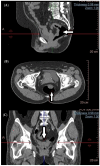Imaging and Metabolic Diagnostic Methods in the Stage Assessment of Rectal Cancer
- PMID: 39061192
- PMCID: PMC11275086
- DOI: 10.3390/cancers16142553
Imaging and Metabolic Diagnostic Methods in the Stage Assessment of Rectal Cancer
Abstract
Rectal cancer (RC) is a prevalent malignancy with significant morbidity and mortality rates. The accurate staging of RC is crucial for optimal treatment planning and patient outcomes. This review aims to summarize the current literature on imaging and metabolic diagnostic methods used in the stage assessment of RC. Various imaging modalities play a pivotal role in the initial evaluation and staging of RC. These include magnetic resonance imaging (MRI), computed tomography (CT), and endorectal ultrasound (ERUS). MRI has emerged as the gold standard for local staging due to its superior soft tissue resolution and ability to assess tumor invasion depth, lymph node involvement, and the presence of extramural vascular invasion. CT imaging provides valuable information about distant metastases and helps determine the feasibility of surgical resection. ERUS aids in assessing tumor depth, perirectal lymph nodes, and sphincter involvement. Understanding the strengths and limitations of each diagnostic modality is essential for accurate staging and treatment decisions in RC. Furthermore, the integration of multiple imaging and metabolic methods, such as PET/CT or PET/MRI, can enhance diagnostic accuracy and provide valuable prognostic information. Thus, a literature review was conducted to investigate and assess the effectiveness and accuracy of diagnostic methods, both imaging and metabolic, in the stage assessment of RC.
Keywords: CT; EUS; MRI; PET/CT; PET/MRI; imaging diagnosis; rectal cancer; stage assessment.
Conflict of interest statement
The authors declare no conflicts of interest.
Figures



Similar articles
-
The role of ultrasound in primary workup of cervical cancer staging (ESGO, ESTRO, ESP cervical cancer guidelines).Ceska Gynekol. 2019 Winter;84(1):40-48. Ceska Gynekol. 2019. PMID: 31213057 Review. English.
-
Endorectal ultrasound in the preoperative evaluation of rectal cancer.Clin Colorectal Cancer. 2004 Jul;4(2):124-32. doi: 10.3816/ccc.2004.n.015. Clin Colorectal Cancer. 2004. PMID: 15285819 Review.
-
Endorectal ultrasonography versus phased-array magnetic resonance imaging for preoperative staging of rectal cancer.World J Gastroenterol. 2008 Jun 14;14(22):3504-10. doi: 10.3748/wjg.14.3504. World J Gastroenterol. 2008. PMID: 18567078 Free PMC article.
-
Endorectal coil MRI in local staging of rectal cancer.Radiol Med. 2002 Jan-Feb;103(1-2):74-83. Radiol Med. 2002. PMID: 11859303 English, Italian.
-
Anorectal staging: is EUS necessary?Minerva Med. 2014 Oct;105(5):423-36. Epub 2014 Jul 7. Minerva Med. 2014. PMID: 25000219 Review.
Cited by
-
PET/MRI is superior to PET/CT in detecting oesophago and gastric carcinomas: a meta-analysis.Cancer Imaging. 2025 Apr 7;25(1):50. doi: 10.1186/s40644-025-00871-3. Cancer Imaging. 2025. PMID: 40197531 Free PMC article.
-
Imaging Assessment of the Response to Neoadjuvant Treatment in Rectal Cancer in Relation to Postoperative Pathological Outcomes.Curr Health Sci J. 2024 Oct-Dec;50(5):585-598. doi: 10.12865/CHSJ.50.04.13. Epub 2024 Dec 31. Curr Health Sci J. 2024. PMID: 40143884 Free PMC article.
-
Comparison between Substance P and Calcitonin Gene-Related Peptide and Their Receptors in Colorectal Adenocarcinoma.J Clin Med. 2024 Sep 22;13(18):5616. doi: 10.3390/jcm13185616. J Clin Med. 2024. PMID: 39337103 Free PMC article.
References
-
- Giesen L.J.X., Olthof P.B., Elferink M.A.G., van Westreenen H.L., Beets G.L., Verhoef C., Dekker J.W.T. Changes in rectal cancer treatment after the introduction of a national screening program; Increasing use of less invasive strategies within a national cohort. Eur. J. Surg. Oncol. 2022;48:1117–1122. doi: 10.1016/j.ejso.2021.11.132. - DOI - PubMed
-
- Didkowska J., Barańska K., Miklewska M.J., Wojciechowska U. Cancer incidence and mortality in Poland in 2023, Nowotwory. J. Oncol. 2024;74:75–93. doi: 10.5603/NJO.99065. - DOI
Publication types
LinkOut - more resources
Full Text Sources

